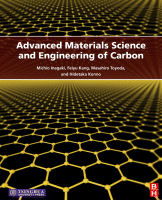Browse content
Table of contents
Actions for selected chapters
- Full text access
- Book chapterAbstract only
Chapter 1 - Introduction
Pages 1-13 - Book chapterAbstract only
Chapter 2 - Carbon Nanotubes: Synthesis and Formation
Pages 15-40 - Book chapterAbstract only
Chapter 3 - Graphene: Synthesis and Preparation
Pages 41-65 - Book chapterAbstract only
Chapter 4 - Carbonization Under Pressure
Pages 67-85 - Book chapterAbstract only
Chapter 5 - Stress Graphitization
Pages 87-110 - Book chapterAbstract only
Chapter 6 - Glass-like Carbon: Its Activation and Graphitization
Pages 111-132 - Book chapterAbstract only
Chapter 7 - Template Carbonization: Morphology and Pore Control
Pages 133-163 - Book chapterAbstract only
Chapter 8 - Carbon Nanofibers Via Electrospinning
Pages 165-188 - Book chapterAbstract only
Chapter 9 - Carbon Foams
Pages 189-214 - Book chapterAbstract only
Chapter 10 - Nanoporous Carbon Membranes and Webs
Pages 215-236 - Book chapterAbstract only
Chapter 11 - Carbon Materials for Electrochemical Capacitors
Pages 237-265 - Book chapterAbstract only
Chapter 12 - Carbon Materials in Lithium-ion Rechargeable Batteries
Pages 267-287 - Book chapterAbstract only
Chapter 13 - Carbon Materials in Photocatalysis
Pages 289-311 - Book chapterAbstract only
Chapter 14 - Carbon Materials for Spilled-oil Recovery
Pages 313-334 - Book chapterAbstract only
Chapter 15 - Carbon Materials for Adsorption of Molecules and Ions
Pages 335-361 - Book chapterAbstract only
Chapter 16 - Highly Oriented Graphite with High Thermal Conductivity
Pages 363-386 - Book chapterAbstract only
Chapter 17 - Isotropic High-density Graphite and Nuclear Applications
Pages 387-410 - Book chapterNo access
Index
Pages 411-434
About the book
Description
Carbon materials are exceptionally diverse in their preparation, structure, texture, and applications. In Advanced Materials Science and Engineering of Carbon, noted carbon scientist Michio Inagaki and his coauthors cover the most recent advances in carbon materials, including new techniques and processes, carbon materials synthesis, and up-to-date descriptions of current carbon-based materials, trends and applications.
Beginning with the synthesis and preparation of nanocarbons, carbon nanotubes, and graphenes, the book then reviews recently developed carbonization techniques, such as templating, electrospinning, foaming, stress graphitization, and the formation of glass-like carbon. The last third of the book is devoted to applications, featuring coverage of carbon materials for energy storage, electrochemical capacitors, lithium-ion rechargeable batteries, and adsorptive storage of hydrogen and methane for environmental protection, photocatalysis, spilled oil recovery, and nuclear applications of isotropic high-density graphite.
Carbon materials are exceptionally diverse in their preparation, structure, texture, and applications. In Advanced Materials Science and Engineering of Carbon, noted carbon scientist Michio Inagaki and his coauthors cover the most recent advances in carbon materials, including new techniques and processes, carbon materials synthesis, and up-to-date descriptions of current carbon-based materials, trends and applications.
Beginning with the synthesis and preparation of nanocarbons, carbon nanotubes, and graphenes, the book then reviews recently developed carbonization techniques, such as templating, electrospinning, foaming, stress graphitization, and the formation of glass-like carbon. The last third of the book is devoted to applications, featuring coverage of carbon materials for energy storage, electrochemical capacitors, lithium-ion rechargeable batteries, and adsorptive storage of hydrogen and methane for environmental protection, photocatalysis, spilled oil recovery, and nuclear applications of isotropic high-density graphite.
Key Features
- A progression from synthesis through modern carbonization techniques to applications gives you a thorough understanding of carbon materials
- Covers a wide range of precursor materials, preparation techniques, and characteristics to inspire your own development of carbonization techniques, carbon materials and applications
- Applications-oriented chapters include timely content on hot topics such as the engineering of carbon nanofibers and carbon materials for various energy-related applications
- A progression from synthesis through modern carbonization techniques to applications gives you a thorough understanding of carbon materials
- Covers a wide range of precursor materials, preparation techniques, and characteristics to inspire your own development of carbonization techniques, carbon materials and applications
- Applications-oriented chapters include timely content on hot topics such as the engineering of carbon nanofibers and carbon materials for various energy-related applications
Details
ISBN
978-0-12-407789-8
Language
English
Published
2014
Copyright
Copyright © 2014 Elsevier Inc. All rights reserved.
Imprint
Butterworth-Heinemann
